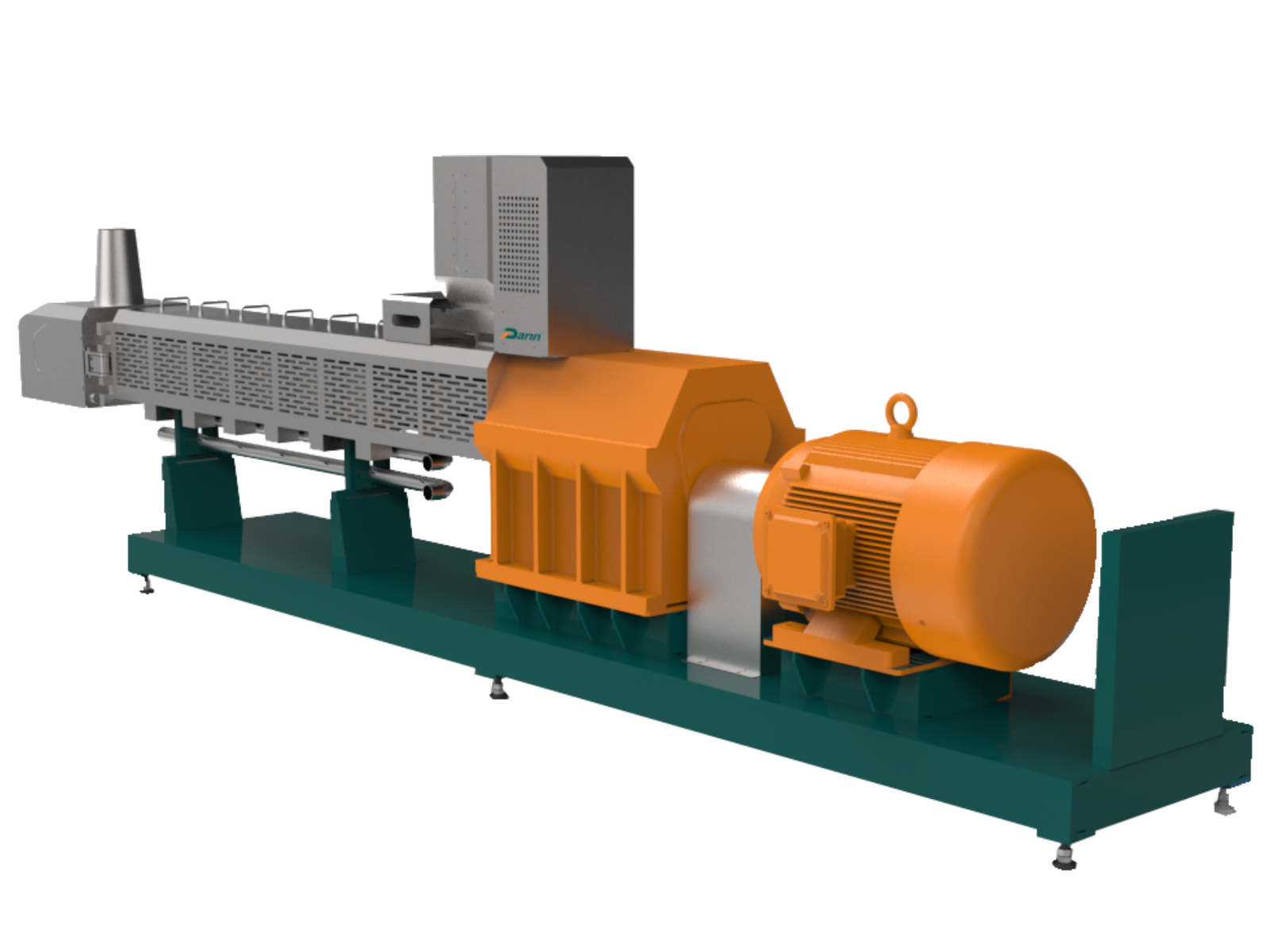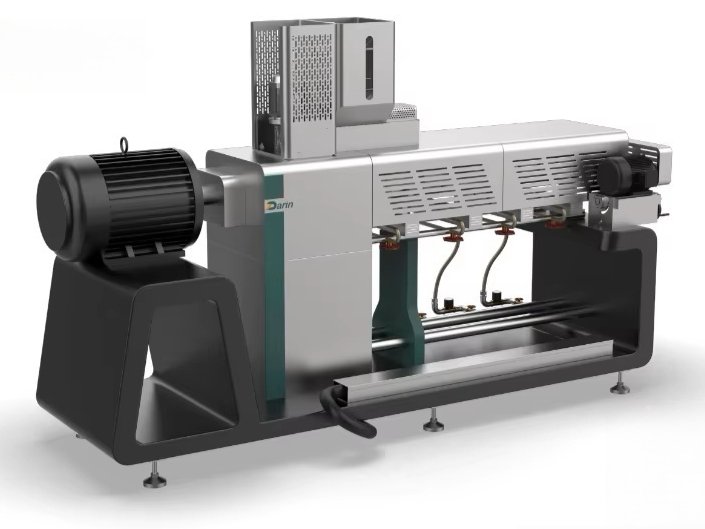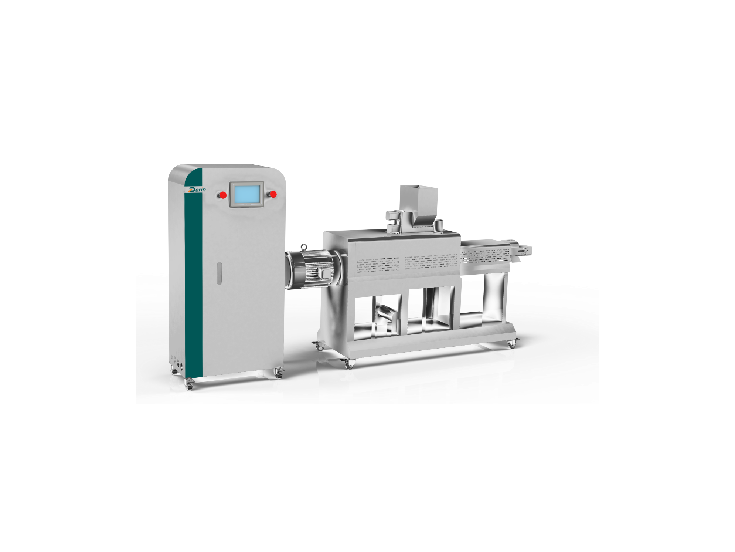Many dog owners struggle to find the perfect diet for their furry companions. With so many options on the market—raw diets, kibble, home-cooked meals—it can be overwhelming. Feeding the wrong balance of nutrients can lead to digestive issues, obesity, or deficiencies that affect your dog’s overall health. That’s where the 80/20 rule comes in. This guideline simplifies dog nutrition, ensuring a balanced diet without unnecessary complications.
The 80/20 rule for dog food suggests that 80% of your dog’s diet should consist of high-quality animal-based proteins and fats, while the remaining 20% should come from fruits, vegetables, and other plant-based ingredients. This ratio helps provide the necessary nutrients for optimal health, supporting muscle development, energy levels, and overall well-being.
While the 80/20 rule is a useful guideline, it's essential to understand how it applies to different feeding styles, from raw diets to commercial dog food. Let’s explore what makes up this ratio, why it’s effective, and how to implement it properly.
What Does the 80/20 Rule Mean for Dog Nutrition?
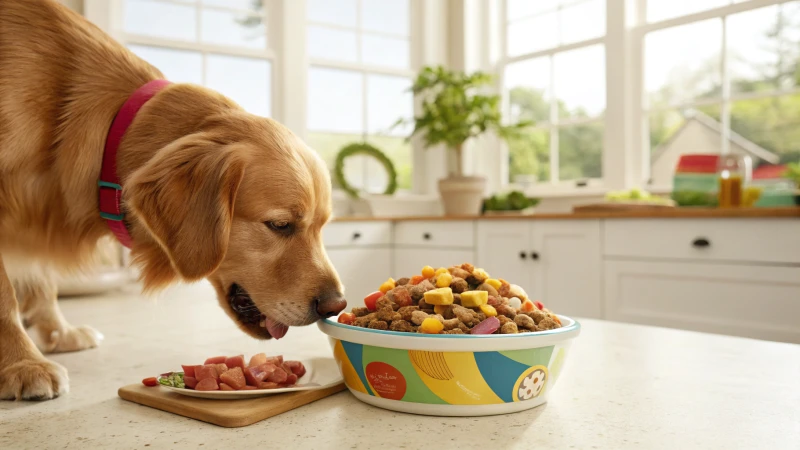
Ensuring your dog's optimal health is a top priority for every responsible pet owner. However, with so much conflicting information about what to feed your dog, it can be overwhelming to make the right choices. Many pet nutritionists and veterinarians recommend the 80/20 rule for dog nutrition, which simplifies feeding by focusing on an ideal balance of nutrients. Misunderstanding this rule can lead to dietary deficiencies or obesity, affecting your dog’s long-term well-being. The key is knowing how to apply this rule correctly and tailor it to your dog’s specific needs.
What is the 80/20 Rule in Dog Nutrition?
The 80/20 rule in dog nutrition states that 80% of a dog's diet should consist of high-quality, species-appropriate foods such as meat, organs, and bones, while the remaining 20% can include complementary foods like fruits, vegetables, and healthy extras. This ratio ensures that dogs receive essential proteins and fats while benefiting from additional fiber, vitamins, and minerals.
This guideline helps maintain a nutritionally complete diet while allowing for variety and occasional treats. The principle is especially popular among raw feeders but can also be adapted to kibble-based or home-cooked diets.
Why Should You Follow the 80/20 Rule?
The 80/20 rule is based on biological appropriateness and digestive efficiency. Dogs are facultative carnivores, meaning they thrive primarily on animal-based diets but can digest and benefit from plant-based nutrients. The 80/20 ratio ensures a diet rich in protein while allowing for a moderate intake of fiber, antioxidants, and other micronutrients from non-meat sources.
Dogs are obligate carnivores and cannot digest plant-based foods.False
Dogs are facultative carnivores, meaning they primarily thrive on meat but can digest and benefit from plant-based foods.
Breaking Down the 80/20 Rule: What to Feed Your Dog?
80% Essential Animal-Based Foods
This portion consists of muscle meat, organ meat, and bones, which supply the core nutrients dogs need:
| Component | Purpose | Examples |
|---|---|---|
| Muscle Meat (50-60%) | Provides protein and essential amino acids | Chicken, beef, turkey, lamb, pork, fish |
| Organ Meat (10-15%) | Supplies vitamins, minerals, and taurine | Liver, kidney, heart, spleen, brain |
| Edible Bones (10-15%) | Source of calcium and phosphorus, aids dental health | Chicken necks, wings, beef ribs, turkey necks |
Animal-based foods are highly bioavailable, meaning dogs absorb and utilize the nutrients efficiently.
20% Complementary Plant-Based Foods
This portion includes fruits, vegetables, and other healthy extras that support digestion, immunity, and overall health:
| Category | Benefits | Examples |
|---|---|---|
| Vegetables (10-15%) | Fiber, antioxidants, gut health | Carrots, pumpkin, spinach, broccoli, kale |
| Fruits (5-10%) | Natural vitamins, hydration, low-calorie treats | Blueberries, apples, bananas, watermelon |
| Healthy Extras (Optional) | Probiotics, omega fatty acids, joint support | Greek yogurt, chia seeds, turmeric, fish oil |
These ingredients should be steamed or pureed for better digestibility and nutrient absorption.
Common Mistakes When Applying the 80/20 Rule
Even though the 80/20 guideline is simple, there are a few pitfalls to avoid:
1. Ignoring Nutritional Balance
The 80/20 rule does not mean randomly throwing together meats and vegetables. Each component should be selected for its nutritional value to ensure your dog receives a balanced diet.
2. Overfeeding Treats and Extras
While fruits and vegetables are beneficial, too much can lead to excess sugar intake, weight gain, or digestive issues. Stick to the recommended proportions.
3. Choosing the Wrong Bones
Not all bones are safe! Cooked bones splinter and can cause choking or internal injuries. Stick to raw, meaty bones appropriate for your dog's size.
Raw vs. Kibble: Can the 80/20 Rule Apply to All Diets?
Yes! Whether you feed raw, kibble, or a home-cooked diet, the 80/20 rule can be adapted:
| Diet Type | How to Implement the 80/20 Rule |
|---|---|
| Raw Diet | Ensure 80% animal-based (meat, organs, bones) and 20% plant-based foods |
| Kibble-Based Diet | Choose high-protein, meat-first kibble and supplement with fresh, whole-food toppers |
| Home-Cooked Diet | Carefully balance protein, healthy fats, fiber, and micronutrients |
Regardless of the diet, avoid artificial preservatives, fillers, and highly processed foods.
FAQs About the 80/20 Rule in Dog Nutrition
Can I Adjust the 80/20 Ratio for My Dog?
Yes! Some dogs, like working breeds or those with high energy needs, may require a 90/10 ratio, while senior or less active dogs might thrive on 70/30.
What Are the Best Protein Sources for Dogs?
Lean meats like chicken, turkey, and fish are excellent, but variety is key. Rotating between beef, lamb, and organ meats provides diverse amino acids and nutrients.
Are Carbs Necessary in a Dog's Diet?
Unlike humans, dogs do not require carbohydrates for energy. However, small amounts of fiber-rich carbs can support digestion.
Dogs need carbohydrates in their diet for energy.False
Dogs primarily derive energy from fats and proteins, not carbohydrates.
Final Thoughts: Is the 80/20 Rule Right for Your Dog?
The 80/20 rule is a great starting point for a balanced diet, ensuring your dog gets the necessary nutrients while leaving room for beneficial extras. Whether feeding raw, kibble, or home-cooked meals, the key is quality and balance. Always consult your vet before making major dietary changes.
Looking for dog food machine that aligns with the 80/20 rule? Contact us today for expert recommendations on high-quality nutrition tailored to your dog's needs!
Why Is 80% Animal-Based Protein and Fat Essential for Dogs?

Many dog owners are unaware that their pets' health is heavily influenced by the type and composition of their diet. One of the most critical aspects of canine nutrition is ensuring that at least 80% of a dog's diet consists of animal-based protein and fat. Failing to provide adequate animal-sourced nutrients can result in poor muscle development, weakened immunity, and chronic health issues. Understanding why this ratio is essential will help pet owners make the best choices for their dogs' long-term well-being.
Why Do Dogs Need 80% Animal-Based Protein and Fat?
Dogs require 80% animal-based protein and fat because they are facultative carnivores, meaning their bodies are designed to thrive on a diet primarily consisting of meat, organs, and bones. Animal-based proteins provide essential amino acids for muscle development, immune function, and overall health, while animal fats serve as a dense energy source, support cognitive function, and maintain healthy skin and coat.
This composition ensures that dogs receive highly bioavailable nutrients, meaning their bodies can efficiently absorb and utilize these proteins and fats to maintain optimal health.
The Role of Animal-Based Proteins in Dog Health
1. Essential Amino Acids for Muscle Development and Repair
Protein is composed of amino acids, which are the building blocks of muscle, tissues, enzymes, and hormones. Unlike humans, who can obtain some essential amino acids from plant sources, dogs require animal-based proteins for complete amino acid profiles.
| Essential Amino Acid | Function | Sources |
|---|---|---|
| Arginine | Supports immune system and detoxifies ammonia | Chicken, beef, turkey, lamb |
| Lysine | Aids muscle growth, calcium absorption | Fish, beef, pork, poultry |
| Methionine | Supports skin and coat health | Lamb, fish, eggs |
| Taurine | Essential for heart function and vision | Organ meats, fish |
Animal-based proteins contain all 10 essential amino acids that dogs cannot produce on their own, making them superior to plant-based proteins.
2. Bioavailability and Digestibility
The bioavailability of a nutrient refers to how easily an organism can absorb and use it. Animal proteins have the highest biological value (BV), meaning they are easier for dogs to digest and convert into energy.
| Protein Source | Biological Value (BV) | Digestibility |
|---|---|---|
| Eggs | 100 | Highly digestible |
| Chicken | 92 | Easily absorbed |
| Beef | 78 | Requires more breakdown |
| Plant-based (soy, peas, grains) | 50-70 | Less bioavailable, contains anti-nutrients |
Since animal proteins are easier to digest, they provide more nutrients per calorie compared to plant-based proteins, which contain fiber and anti-nutrients that reduce absorption.
The Role of Animal-Based Fats in Dog Health
1. Primary Energy Source
Dogs rely on fat as their primary energy source, unlike humans, who depend on carbohydrates. Animal fats provide twice as much energy per gram as protein or carbohydrates, making them essential for active dogs.
| Nutrient | Calories per Gram |
|---|---|
| Protein | 4 kcal |
| Carbohydrates | 4 kcal |
| Fat | 9 kcal |
A diet rich in animal fats ensures sustained energy levels and prevents blood sugar spikes seen with high-carbohydrate diets.
2. Supports Brain and Cognitive Function
Fats contain omega-3 and omega-6 fatty acids, which are essential for brain health, cognitive function, and learning ability, especially in puppies and senior dogs.
| Fatty Acid | Benefit | Sources |
|---|---|---|
| DHA (Omega-3) | Supports brain and eye development | Fish oil, salmon |
| EPA (Omega-3) | Reduces inflammation, supports heart health | Mackerel, sardines |
| Linoleic Acid (Omega-6) | Maintains skin and coat health | Chicken fat, beef fat |
A deficiency in these essential fatty acids can lead to dull coats, joint inflammation, and cognitive decline in aging dogs.
Common Misconceptions About Animal-Based Diets
1. "Dogs Need Carbohydrates for Energy" – False!
Many commercial dog foods contain 50% or more carbohydrates, yet dogs do not have a dietary requirement for carbohydrates. They derive energy from fats and proteins, making a high-carb diet unnecessary.
Dogs require carbohydrates for energy.False
Dogs primarily derive energy from fats and proteins, not carbohydrates.
2. "Plant Proteins Are Just as Good as Animal Proteins" – False!
While plant proteins contain some amino acids, they lack key essential amino acids like taurine, methionine, and lysine, which are crucial for muscle maintenance and heart health.
Plant-based proteins provide complete amino acid profiles for dogs.False
Dogs require animal-based proteins to obtain all essential amino acids for optimal health.
How to Ensure Your Dog Gets the Right Balance of Animal-Based Protein and Fat
| Factor | Recommendation |
|---|---|
| Protein Percentage | At least 40-50% of total diet |
| Fat Percentage | 30-40% of total diet |
| Carbohydrate Limit | Less than 10% of total diet |
If feeding raw or homemade meals, ensure the following ratio:
- 50-60% muscle meat
- 10-15% organ meat
- 10-15% edible bones
- 10-20% vegetables, fruits, and healthy extras
For kibble feeders, choose brands that list real meat as the first ingredient and avoid corn, wheat, soy, and artificial additives.
Final Thoughts: Why 80% Animal-Based Protein and Fat Is Crucial
The 80% animal-based nutrition model aligns with dogs' evolutionary dietary needs, ensuring muscle maintenance, immune function, cognitive health, and sustained energy. High-quality animal proteins and fats are more digestible, bioavailable, and nutrient-dense than plant-based alternatives. Whether feeding raw, cooked, or kibble-based diets, prioritizing animal-based ingredients will significantly improve your dog's health and longevity.
Need expert guidance on choosing the best dog food machine? Contact us today for personalized recommendations tailored to your needs!
What Types of Plant-Based Foods Make Up the Remaining 20% of a Dog’s Diet?
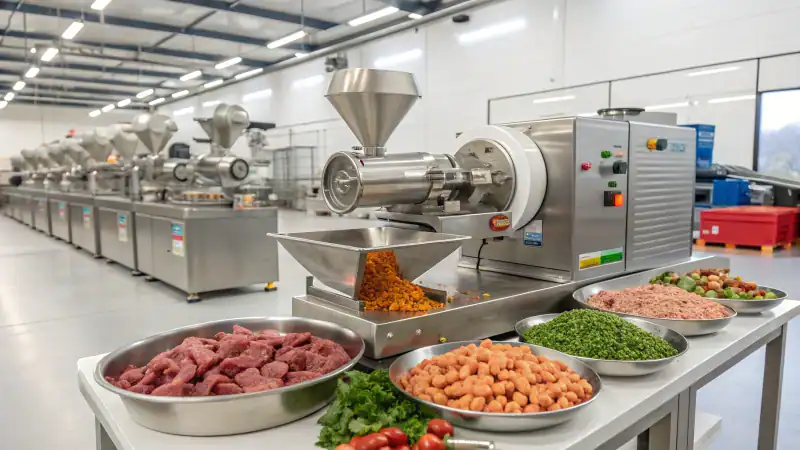
While 80% of a dog's diet should be composed of high-quality animal-based proteins and fats, the remaining 20% should consist of plant-based foods that offer fiber, vitamins, minerals, and antioxidants. However, not all plant-based ingredients are safe or beneficial for dogs. Many pet owners mistakenly believe that dogs need grains or fillers, but in reality, the right fruits, vegetables, and functional plant-based foods can enhance digestion, immune function, and overall health. Understanding the best plant-based foods to include—and which ones to avoid—will help ensure a balanced, species-appropriate diet for your dog.
What Plant-Based Foods Should Make Up the 20% of a Dog’s Diet?
The best plant-based foods for dogs include non-starchy vegetables, low-sugar fruits, and functional plant-based additives such as herbs, seeds, and fermented foods. These provide essential fiber, antioxidants, and micronutrients without unnecessary carbohydrates.
Dogs are facultative carnivores, meaning they thrive primarily on animal proteins but can digest and benefit from certain plant-based nutrients. The key is selecting bioavailable, low-glycemic, and nutrient-dense plant foods while avoiding harmful or unnecessary ones.
Best Vegetables for Dogs (10-15%)
Vegetables provide fiber for digestion, antioxidants for immune health, and essential vitamins and minerals. However, some vegetables are more beneficial than others.
| Vegetable | Nutritional Benefit | Preparation |
|---|---|---|
| Carrots | Rich in beta-carotene for eye health | Raw or steamed |
| Pumpkin | Supports digestion and relieves constipation | Cooked, pureed |
| Spinach | High in iron, magnesium, and antioxidants | Lightly steamed (raw in small amounts) |
| Broccoli | Provides vitamin C, fiber, and anti-cancer compounds | Steamed, in small amounts |
| Kale | Rich in vitamins K, A, and C for immune support | Lightly steamed (avoid excess due to oxalates) |
| Zucchini | Low-calorie, hydrating, and full of fiber | Raw or cooked |
| Celery | Contains antioxidants and aids fresh breath | Raw, chopped |
| Beets | Supports liver function and blood health | Cooked, in moderation |
| Sweet Potatoes | Excellent source of fiber and vitamin A | Cooked, in small amounts |
Vegetables to Avoid
- Onions, garlic, leeks, and chives – Toxic and can cause anemia
- Raw potatoes – Contain solanine, which is toxic
- Corn and soy – Hard to digest and common allergens
- Excess legumes (lentils, beans, peas) – Can cause gas and digestive issues
Best Fruits for Dogs (5-10%)
Fruits provide natural vitamins, hydration, and antioxidants but should be given in moderation due to their sugar content.
| Fruit | Nutritional Benefit | Preparation |
|---|---|---|
| Blueberries | High in antioxidants and supports brain health | Raw, whole or mashed |
| Apples | Provides vitamin C and fiber | Remove seeds, slice |
| Bananas | High in potassium and energy | Raw, in moderation |
| Watermelon | Hydrating and rich in lycopene | Remove seeds and rind |
| Strawberries | Supports immune system with vitamin C | Raw, mashed or whole |
| Pineapple | Contains digestive enzymes and vitamin C | Raw, in moderation |
| Cranberries | Helps prevent UTIs | Dried (unsweetened) or fresh |
| Mango | Rich in vitamins A and E | Remove skin and pit, serve in moderation |
| Pears | Supports digestion and immune health | Remove seeds and core |
Fruits to Avoid
- Grapes and raisins – Highly toxic and can cause kidney failure
- Cherries – Contain cyanide in pits
- Avocados – Contain persin, which is toxic to dogs
Functional Plant-Based Additives (5%)
Functional plant-based foods enhance gut health, reduce inflammation, and provide additional nutrients that improve overall wellness.
| Food | Benefit | How to Feed |
|---|---|---|
| Chia Seeds | Omega-3s for skin and joint health | Sprinkle over food |
| Flaxseeds | Supports digestion and hormone balance | Ground, mixed in food |
| Coconut Oil | Antimicrobial, supports brain and skin health | Drizzle over meals |
| Turmeric | Anti-inflammatory, supports joints | Mix with black pepper for absorption |
| Ginger | Aids digestion and relieves nausea | Fresh, grated in small amounts |
| Parsley | Supports fresh breath and detoxification | Chopped, sprinkled |
| Seaweed/Kelp | Provides iodine for thyroid support | Small amounts as powder |
| Fermented Foods (Kefir, Sauerkraut, Yogurt) | Supports gut microbiome and digestion | Probiotic-rich, in small amounts |
Are Grains Necessary in a Dog’s Diet?
Dogs do not require grains or high amounts of carbohydrates in their diet. While some grains provide fiber, many are used as cheap fillers in commercial dog food and offer little nutritional value. If including grains, opt for whole, unprocessed options like:
| Grain | Benefit | How to Serve |
|---|---|---|
| Quinoa | High in protein and fiber | Cooked, in small portions |
| Brown Rice | Supports digestion, good for sensitive stomachs | Cooked, in moderation |
| Oats | Rich in fiber, helps maintain blood sugar levels | Cooked, unflavored |
Dogs require grains in their diet for energy and digestion.False
Dogs do not have a dietary requirement for grains and can thrive without them.
How to Incorporate the 20% Plant-Based Foods in a Dog’s Diet
- Blend or steam vegetables for better digestibility
- Rotate fruits and veggies for a variety of nutrients
- Use plant-based foods as meal toppers or treats
- Limit sugary fruits to avoid unnecessary weight gain
- Monitor for allergies when introducing new foods
Final Thoughts: Choosing the Right 20% Plant-Based Foods for Your Dog
Including the right plant-based foods in your dog's diet can provide essential fiber, antioxidants, and micronutrients that support digestion, immune function, and overall well-being. Focus on low-glycemic vegetables, small portions of fruit, and functional plant-based additives while avoiding toxic or unnecessary fillers. When balanced correctly, the 80/20 rule ensures optimal canine health and aligns with dogs' evolutionary dietary needs.
Looking for expert guidance on dog food making machine? Contact us today for personalized nutrition plans and high-quality dog food recommendations!
How Does the 80/20 Rule Compare to Other Feeding Methods?
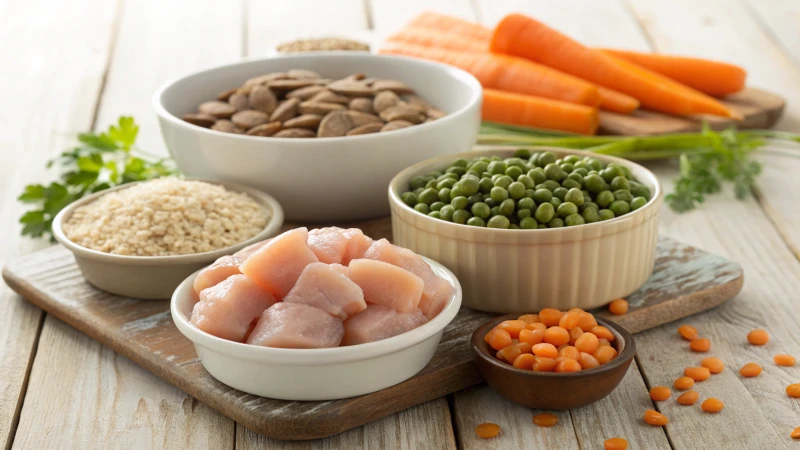
Dog owners are often overwhelmed by the variety of feeding methods available, each claiming to be the best for canine health. While the 80/20 rule (80% animal-based protein and fat, 20% plant-based foods) is gaining popularity, other feeding approaches such as commercial kibble, raw diets, home-cooked meals, and prescription diets also have their advocates. The question remains: How does the 80/20 rule compare to these feeding methods in terms of nutrition, digestibility, and long-term health benefits? Understanding the pros and cons of each approach will help you make the best dietary choice for your dog.
How Does the 80/20 Rule Compare to Other Dog Diets?
The 80/20 rule prioritizes high-quality animal proteins and fats while incorporating a small percentage of nutrient-dense plant-based foods. Compared to kibble, home-cooked, and raw diets, the 80/20 approach offers a biologically appropriate balance, promoting muscle development, digestive health, and immune support without unnecessary fillers or excessive carbohydrates.
To better understand how the 80/20 rule compares, let’s analyze the major feeding methods side by side.
Comparison Table: 80/20 Rule vs. Other Dog Feeding Methods
| Feeding Method | Composition | Pros | Cons | Best For |
|---|---|---|---|---|
| 80/20 Rule (Balanced Meat-Based Diet) | 80% animal protein and fat, 20% plant-based foods (veggies, fruits, seeds, functional foods) | - Biologically appropriate - High protein, low carbs - Supports digestion & immune system - Flexible (raw or cooked) | - Requires sourcing quality meat - Needs careful portion control | Owners wanting a natural, balanced approach without ultra-processing |
| Commercial Kibble | 40-60% carbohydrates, 20-30% protein (often plant-based), fats, vitamins, and preservatives | - Convenient & long shelf life - Budget-friendly options - Formulated for basic nutrition | - High in fillers (corn, wheat, soy) - Low moisture, can cause dehydration - Often includes artificial preservatives | Owners seeking affordable, convenient feeding but willing to sacrifice quality |
| Raw Diet (BARF/Prey Model) | 70-90% raw meat, organs, and bones, 10-30% minimal plant-based content | - Mimics ancestral diet - High in bioavailable protein - Supports dental & coat health | - Can be expensive - Risk of bacterial contamination - Requires careful nutrient balance | Owners who prefer a species-appropriate, natural diet and can commit to proper handling |
| Home-Cooked Meals | Varies: typically 40-60% meat, 20-30% carbs, 10-20% vegetables | - Customizable for dog's needs - No preservatives - High-quality ingredients | - Time-consuming to prepare - Risk of nutritional imbalance - May lack essential vitamins | Owners wanting fresh, preservative-free meals but willing to work on nutrient balancing |
| Prescription Diets (Vet-Recommended) | Formulated for medical conditions (kidney, liver, allergies) | - Targets specific health issues - Often scientifically backed | - Often contains fillers and artificial additives - Expensive - May not suit all dogs | Dogs with specific medical conditions requiring specialized diets |
80/20 Rule vs. Commercial Kibble
Key Differences:
- 80/20 focuses on high-quality protein and healthy fats, while most kibble contains plant-based protein fillers (corn, soy, pea protein) that are less digestible for dogs.
- Kibble often contains 50% or more carbohydrates, which can contribute to obesity and inflammation. The 80/20 rule, on the other hand, keeps carbs below 10-20%, ensuring a more species-appropriate diet.
- Kibble has a long shelf life but lacks moisture, which can lead to chronic dehydration. The 80/20 rule allows for fresh, high-moisture meals that improve digestion and kidney health.
Kibble provides all the necessary nutrients dogs need for optimal health.False
Most commercial kibble is high in carbohydrates and processed ingredients, which can contribute to inflammation, obesity, and poor digestion.
80/20 Rule vs. Raw Diets (BARF & Prey Model)
Key Differences:
- Both 80/20 and raw diets prioritize high-protein, low-carb nutrition, making them more biologically appropriate than kibble.
- Raw diets often exclude plant-based foods entirely, while the 80/20 rule includes 20% plant-based foods for added fiber, vitamins, and antioxidants.
- The risk of bacterial contamination is higher with raw diets if not handled properly, whereas the 80/20 rule can be applied to cooked or raw feeding, offering flexibility.
- Some raw diets lack key nutrients like fiber, vitamins, and omega fatty acids, which the 80/20 approach naturally includes through carefully selected fruits, vegetables, and functional additives.
Dogs should only eat raw meat and bones, with no plant-based foods.False
Dogs are facultative carnivores and benefit from small amounts of plant-based foods for fiber, antioxidants, and digestive health.
80/20 Rule vs. Home-Cooked Meals
Key Differences:
- Home-cooked diets vary widely in nutrient composition, while the 80/20 rule provides a structured approach to ensure proper macronutrient balance.
- Many home-cooked diets contain excessive carbohydrates (20-40%), while the 80/20 method keeps carbs below 20%, aligning more with a dog's natural dietary needs.
- Nutritional deficiencies are common in home-cooked diets if not properly formulated, whereas the 80/20 rule provides a clear framework for nutrient balance.
Which Feeding Method Is Best for Your Dog?
| Best Choice If You Want… | Recommended Feeding Method |
|---|---|
| Convenience & affordability | Commercial kibble |
| A natural, balanced, meat-based diet with fiber & nutrients | 80/20 rule |
| High-protein, carb-free diet with raw bones | Raw diet |
| Fresh, home-prepared meals with custom ingredients | Home-cooked |
| Medical support for specific conditions | Prescription diets |
Final Thoughts: Why the 80/20 Rule Stands Out
The 80/20 feeding approach offers the best of both worlds—a high-protein, meat-based diet combined with the essential nutrients from plant-based foods. Unlike kibble, it eliminates unnecessary fillers and artificial preservatives, while also avoiding the nutrient imbalances and potential risks of raw-only diets. Whether raw or cooked, following the 80/20 rule ensures a complete, natural diet that supports long-term canine health.
Looking for customized & high-quality dog food production machine recommendations? Contact us today to optimize your dog food machine.
Can All Dogs Follow the 80/20 Diet, or Are There Exceptions?

The 80/20 diet—where 80% of a dog's diet is made up of animal-based proteins and fats, while 20% consists of plant-based nutrients—is widely regarded as a balanced, species-appropriate approach. However, while this diet suits most healthy dogs, there are certain exceptions where modifications are necessary. Factors such as age, breed, health conditions, and activity levels can all affect how well a dog adapts to this feeding method.
Can All Dogs Follow the 80/20 Diet?
Most dogs thrive on the 80/20 diet because it aligns with their natural dietary needs, emphasizing high-quality protein and fat with a controlled amount of plant-based nutrients. However, exceptions include dogs with specific health conditions, dietary sensitivities, and unique metabolic needs that may require adjustments in macronutrient ratios or specialized feeding plans.
Which Dogs Benefit Most from the 80/20 Diet?
The 80/20 diet is highly effective for the following categories of dogs:
1. Active and Working Dogs 🐕🦺🏃♂️
- Breeds such as Border Collies, Huskies, Belgian Malinois, and Labrador Retrievers require high-energy diets.
- The 80% animal-based protein and fat provide sustained energy and muscle maintenance, making it ideal for active dogs.
- Example Diet Adjustment: Increase animal-based fats (e.g., salmon oil, beef fat) to boost endurance and prevent muscle fatigue.
2. Puppies and Growing Dogs 🐶🌱
- Puppies need high-quality protein and essential fatty acids for rapid growth and brain development.
- The 80/20 rule supports proper skeletal and muscular formation without excessive carbohydrates.
- Example Diet Adjustment: Include more DHA-rich foods (e.g., fish, eggs) to support cognitive and eye development.
3. Senior Dogs 🦴🧓
- Aging dogs benefit from easily digestible proteins and anti-inflammatory fats.
- The 80/20 diet can prevent muscle wasting and maintain mobility.
- Example Diet Adjustment: Increase collagen-rich foods (e.g., chicken feet, bone broth) to support joint health.
4. Overweight Dogs ⚖️🐕
- Many overweight dogs consume too many carbohydrates in commercial kibble.
- The 80/20 diet’s high protein and moderate fat content helps promote lean muscle mass while reducing excess body fat.
- Example Diet Adjustment: Reduce caloric intake while maintaining high protein to preserve muscle mass.
Which Dogs May Need Adjustments to the 80/20 Diet?
While the 80/20 diet is ideal for most dogs, some dogs may require modifications due to medical conditions or specific dietary needs.
1. Dogs with Kidney Disease 🩺🚰
- Issue: High protein intake may stress the kidneys in dogs with chronic kidney disease (CKD).
- Solution: Reduce protein to 50-60% and increase moisture content with hydrating foods like bone broth and steamed vegetables.
- Example Diet Adjustment: Include omega-3-rich fish to reduce inflammation and support kidney function.
Dogs with kidney disease should avoid all high-protein diets.False
Moderate protein intake is still necessary to prevent muscle loss, but dietary adjustments should be made based on kidney function.
2. Dogs with Pancreatitis 🩺⚠️
- Issue: Dogs with pancreatitis struggle to digest high-fat diets.
- Solution: Reduce fat content to 10-15% while maintaining high-quality protein sources.
- Example Diet Adjustment: Choose lean meats (e.g., turkey, white fish) and avoid fatty cuts like pork belly or lamb.
3. Diabetic Dogs 🩸📉
- Issue: Diabetic dogs require stable blood sugar levels and must avoid high-glycemic foods.
- Solution: Maintain high protein and moderate fat, while ensuring the plant-based portion is low in starchy vegetables.
- Example Diet Adjustment: Focus on low-glycemic vegetables (e.g., spinach, zucchini, kale) and eliminate high-carb foods like sweet potatoes and rice.
Diabetic dogs should consume a low-protein diet.False
Diabetic dogs benefit from high-quality protein to maintain lean muscle mass while minimizing carbohydrate intake.
4. Toy Breeds and Small Dogs 🐩🐾
- Issue: Small dogs have higher metabolisms and require more frequent meals.
- Solution: Maintain the 80/20 balance, but ensure small portion sizes with nutrient-dense foods.
- Example Diet Adjustment: Offer small, frequent meals and include healthy fats like coconut oil for energy.
5. Large & Giant Breeds (e.g., Great Danes, Mastiffs) 🦴🐕
- Issue: Large dogs are prone to joint issues and need controlled calcium and phosphorus intake.
- Solution: Ensure proper calcium-to-phosphorus ratios in meaty bones and add joint-supportive foods like green-lipped mussels.
- Example Diet Adjustment: Maintain lean proteins and include collagen and glucosamine supplements.
How to Modify the 80/20 Diet for Special Cases
| Dog Type | Recommended Adjustments to the 80/20 Diet |
|---|---|
| Healthy Adult Dogs | Stick to standard 80% animal-based, 20% plant-based ratio |
| Active & Working Dogs | Increase healthy fats for sustained energy |
| Puppies & Senior Dogs | Increase omega-3s & collagen-rich foods |
| Overweight Dogs | Reduce fat intake slightly, focus on lean proteins |
| Dogs with Kidney Issues | Lower protein intake slightly, increase moisture |
| Dogs with Pancreatitis | Reduce fat to 10-15%, focus on lean proteins |
| Diabetic Dogs | Eliminate high-carb plant foods, increase protein |
| Toy Breeds | Offer smaller, more frequent meals |
| Giant Breeds | Control calcium-to-phosphorus ratio, add joint support |
Final Thoughts: Can All Dogs Follow the 80/20 Diet?
For most dogs, the 80/20 rule provides an optimal balance of animal-based proteins and fats with essential plant-based nutrients. However, dogs with specific medical conditions may require adjustments in protein, fat, or carbohydrate intake. Customizing the 80/20 diet based on a dog’s individual needs ensures the best possible health outcomes.
👉 Need help tailoring the 80/20 diet for your dog’s specific needs? Contact us today for personalized nutrition plans and expert recommendations!
How to Transition Your Dog to an 80/20 Diet Safely?

Transitioning your dog to a new diet can be a delicate process, and making sudden changes can lead to digestive upset, refusal to eat, or even nutritional imbalances. Whether your dog is currently eating commercial kibble, home-cooked meals, or another raw diet, switching to an 80/20 diet should be done gradually and methodically. A well-planned transition ensures that your dog adapts smoothly, maintains gut health, and enjoys the benefits of a species-appropriate, balanced diet.
How to Safely Transition Your Dog to the 80/20 Diet?
To safely transition your dog to the 80/20 diet, introduce new foods gradually over 7-14 days, start with easily digestible proteins, monitor stool quality, and adjust portions based on individual tolerance. The key is to prevent digestive upset while ensuring a smooth adjustment to fresh, high-quality ingredients.
The transition process varies depending on your dog's age, health status, and current diet, so following a step-by-step guide will help minimize risks and ensure success.
Step-by-Step Transition Guide to the 80/20 Diet
| Transition Stage | % Old Diet | % New 80/20 Diet | Notes |
|---|---|---|---|
| Days 1-3 | 75% Old Food | 25% New Food | Introduce new proteins slowly, mix into current meals |
| Days 4-6 | 50% Old Food | 50% New Food | Monitor stool consistency and appetite |
| Days 7-9 | 25% Old Food | 75% New Food | Increase new food as long as digestion remains stable |
| Days 10-14 | 0% Old Food | 100% 80/20 Diet | Fully transitioned, continue monitoring for adjustments |
💡 Tip: If your dog experiences mild diarrhea, slow down the transition by staying at each stage for a few extra days.
Step 1: Assess Your Dog’s Current Diet and Health
Before transitioning, consider the following:
✔️ What is your dog currently eating? (Kibble, raw, home-cooked?)
✔️ Any known allergies or sensitivities? (Chicken, beef, grains?)
✔️ Age and activity level? (Puppies and active dogs may need more calories.)
✔️ Underlying health conditions? (Kidney disease, pancreatitis?)
Dogs can switch to a new diet overnight without any issues.False
Sudden diet changes can cause digestive upset, including diarrhea and vomiting. A gradual transition is recommended.
Step 2: Choose High-Quality Animal Proteins
Start with mild, easily digestible proteins such as:
🐔 Chicken – Lean and gentle on digestion
🐟 Turkey or White Fish – Ideal for sensitive stomachs
🥩 Beef or Lamb – Rich in iron and amino acids, but introduce slowly
💡 Tip: Begin with one protein source at a time for the first week before introducing others.
Step 3: Introduce the 20% Plant-Based Portion Gradually
The plant-based 20% portion should include:
- Low-starch vegetables: Carrots, zucchini, spinach, broccoli
- Fruits in moderation: Blueberries, apples, bananas
- Healthy extras: Chia seeds, turmeric, Greek yogurt
🚫 Avoid grains, high-carb foods, and toxic ingredients like onions, grapes, or excessive legumes.
Step 4: Monitor Stool Quality and Digestion
Tracking your dog's stool consistency is the best indicator of how well they are adapting to the new diet.
| Stool Appearance | Meaning | What to Do |
|---|---|---|
| Firm, well-formed | Healthy transition | Continue increasing new diet |
| Soft but not watery | Slight adjustment period | Maintain current stage before progressing |
| Diarrhea or loose stools | Transition too fast | Slow down, introduce more fiber (pumpkin) |
| Constipation (hard, dry) | Need more hydration | Increase water and healthy fats (fish oil) |
💡 Tip: Adding a small amount of plain canned pumpkin can help regulate digestion.
Step 5: Adjust Portions for Your Dog’s Needs
Dogs have different caloric needs based on age, size, and activity level.
| Dog Type | Calories per Day | Daily Food Portion (80/20 Diet) |
|---|---|---|
| Toy Breeds (5-15 lbs) | 200-400 kcal | ½ - 1 cup (split into 2-3 meals) |
| Medium Dogs (25-50 lbs) | 600-1,200 kcal | 1.5 - 2.5 cups |
| Large Dogs (50-100 lbs) | 1,200-2,000 kcal | 2.5 - 4 cups |
| Active/Working Dogs | 2,000+ kcal | Higher fat/protein content |
📌 Adjust portions based on weight maintenance—increase for underweight dogs and reduce for overweight dogs.
Step 6: Add Hydration and Supplements as Needed
Since fresh and raw diets have more moisture than kibble, ensure your dog stays hydrated.
💦 Hydration Tips:
✔️ Always provide fresh, clean water
✔️ Add bone broth for extra minerals and joint support
✔️ Include fermented foods (e.g., kefir, sauerkraut) for probiotics
📌 Key Supplements (If Needed)
- 🦴 Glucosamine & Chondroitin (Joint health for large breeds)
- 🐟 Omega-3 Fish Oil (Skin, coat, brain function)
- 🥩 Digestive Enzymes & Probiotics (For sensitive stomachs)
Dogs do not need hydration from their food as long as they drink water.False
A fresh, moisture-rich diet supports kidney health, digestion, and overall hydration.
Step 7: Maintain a Consistent Feeding Schedule
Keeping a structured meal schedule helps prevent overeating and stabilizes digestion.
| Feeding Frequency | Best For |
|---|---|
| 3-4 small meals per day | Puppies (<6 months) |
| 2 meals per day | Adult dogs (most breeds) |
| 1-2 meals per day | Large breeds & working dogs |
| Small frequent meals | Dogs with digestive issues |
💡 Tip: Avoid feeding too close to exercise time to prevent bloating, especially in deep-chested breeds.
Common Mistakes to Avoid
🚫 Switching too quickly – Leads to stomach upset
🚫 Introducing too many new proteins at once – Hard to identify food sensitivities
🚫 Ignoring hydration needs – Can lead to constipation
🚫 Skipping the monitoring phase – Tracking stool and energy levels is crucial
Final Thoughts: A Safe & Effective Transition to the 80/20 Diet
By gradually introducing new proteins, monitoring digestion, adjusting portions, and ensuring hydration, your dog can transition smoothly to the 80/20 diet without digestive issues. Every dog is unique, so tailoring the process to their specific needs, sensitivities, and activity level will ensure a healthy, long-term dietary shift.
👉 Ready to switch your dog to an 80/20 diet? Contact us today for custom meal plans and expert nutrition advice!
By following the 80/20 rule, you can ensure your dog receives a balanced and nutritious diet without overcomplicating their meals. However, every dog is unique, so adjustments may be necessary based on their age, activity level, and health conditions.
If you’re unsure about the best diet for your pet, contact us for expert guidance on feeding plans tailored to your dog's needs!
FAQ
What is the 80/20 rule for dog food?
The 80/20 rule for dog food means 80% of a dog's diet should come from a complete and balanced commercial food, while 20% can include treats, fresh meats, vegetables, and supplements. This ensures proper nutrition while allowing variety.
What foods can be included in the 20% portion of a dog's diet?
The 20% portion can consist of lean meats (chicken, turkey, beef), vegetables (carrots, broccoli, spinach), fruits (apples, blueberries, bananas), and healthy treats. Avoid toxic foods like grapes, chocolate, onions, and processed junk food.
Why is the 80/20 rule beneficial for dogs?
The 80/20 rule helps maintain a nutritionally balanced diet while adding variety. It prevents excessive treats or unhealthy human food consumption, ensuring dogs receive essential nutrients for overall health and digestion.
Can I use raw food in the 80/20 rule for dog feeding?
Yes, raw food can be part of the 20% portion, but it must be safe and appropriate for dogs. Choose unseasoned, properly handled meats, and avoid bones that may splinter. Consult a vet before introducing raw foods.
What happens if I feed my dog more than 20% treats or fresh food?
Feeding over 20% of unbalanced food can cause nutritional imbalances, obesity, and digestive issues. Dogs need vitamins, minerals, and proteins from a complete diet to stay healthy.
References
- The Importance of Balanced Nutrition for Dogs – akc.org
- Dog Feeding Guidelines – petmd.com
- Healthy Dog Treats and Snacks – aspca.org
- Dog Food and Nutritional Requirements – veterinarypartner.com
- What to Feed Your Dog? – dogfoodadvisor.com
- Raw vs. Processed Dog Food: Pros and Cons – dogsnsw.org.au
- Common Foods That Are Toxic to Dogs – vcaanimalhospital.com
- Choosing the Right Diet for Your Dog – petfinder.com
- How to Avoid Overfeeding Your Dog – avma.org
- The Science Behind Canine Nutrition – wsava.org


